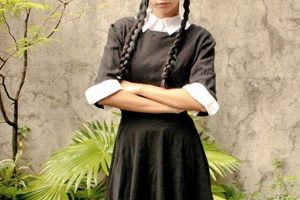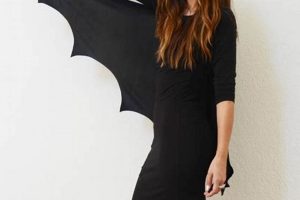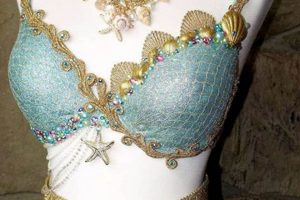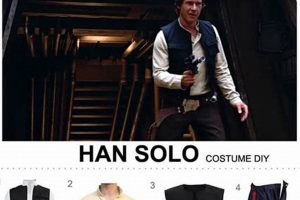Creating attire replicating the microscopic character from popular culture through do-it-yourself methods offers a distinct avenue for self-expression. This process involves crafting a representation of the animated character Sheldon J. Plankton utilizing readily available materials and individual ingenuity. For instance, construction might include felt, cardboard, and paint to emulate the character’s form and features.
The appeal of constructing such a garment lies in its personalized nature and potential cost-effectiveness compared to commercially produced alternatives. Furthermore, the construction process fosters creativity and problem-solving skills. Historically, such endeavors have been a staple of costume creation, particularly in contexts like school plays, themed parties, and fan conventions, allowing individuals to showcase their artistic talents and affinity for specific characters.
The following sections will detail practical approaches to constructing such character-based wearables, including material selection, assembly techniques, and considerations for comfort and durability, ensuring a successful and visually appealing final product.
Tips for Plankton Costume DIY
The creation of a Plankton costume through do-it-yourself methods necessitates careful planning and execution. The following tips aim to guide individuals through the construction process, ensuring a satisfactory and visually accurate representation of the character.
Tip 1: Material Selection: Prioritize lightweight and durable materials. Felt provides a suitable base for the costume’s body, while craft foam offers structural support for facial features such as the single eye and antennae. Consider the comfort of the wearer when selecting fabrics; breathable options are advisable for extended periods of wear.
Tip 2: Pattern Development: Begin with a scaled drawing of the character. This serves as a template for cutting the individual components of the costume. Ensure accurate proportions to maintain the character’s recognizable silhouette. A pattern can be drafted on paper before transferring it to the selected materials.
Tip 3: Eye Construction: The oversized single eye is a defining characteristic. Construct this element using a large, lightweight ball (e.g., foam or plastic) painted white, with a black circle representing the pupil. Secure the eye firmly to the costume’s body to prevent detachment.
Tip 4: Antennae Fabrication: Use flexible wire covered in felt or craft foam to create the antennae. These should be securely attached to the top of the costume, maintaining their shape and position. Consider internal supports to prevent drooping or bending.
Tip 5: Color Accuracy: Adhere to the character’s distinctive green hue. Ensure consistent color application across all costume components to avoid a disjointed appearance. Refer to official character references for accurate color matching.
Tip 6: Closure Mechanisms: Incorporate a secure and easily manageable closure system. Velcro closures or zippers are preferable to buttons or ties, particularly for younger wearers. Ensure the closure is concealed to maintain the costume’s visual integrity.
Tip 7: Mobility Considerations: Design the costume to allow for a reasonable range of movement. Restrictive designs can hinder the wearer’s comfort and participation in activities. Test the costume’s mobility before its intended use.
Adhering to these guidelines will enhance the quality and wearability of the Plankton costume, resulting in a successful and enjoyable representation of the character.
The subsequent section will address specific design considerations for different age groups, tailoring the construction process to suit varying levels of skill and physical capabilities.
1. Material Suitability
Material suitability is a foundational consideration in the effective execution of a do-it-yourself Plankton costume. The selection of appropriate materials directly influences the costume’s visual appeal, structural integrity, and wearer comfort. Inadequate material choices can compromise the overall quality and longevity of the finished product.
- Fabric Weight and Drape
Fabric weight significantly impacts the costume’s appearance and ease of movement. Lightweight fabrics, such as felt or broadcloth, are generally preferred for the main body of the costume. Heavier materials can result in a bulky and cumbersome garment, restricting mobility. The drape of the fabric affects how it falls and conforms to the wearer’s body, influencing the overall silhouette.
- Structural Component Rigidity
Elements such as the character’s single eye and antennae necessitate rigid structural components to maintain their shape. Craft foam, cardboard, or wire frameworks covered in fabric can provide the necessary support. The rigidity of these components must be balanced with safety considerations, ensuring they do not pose a risk of injury to the wearer or others.
- Color Fastness and Dye Selection
The accuracy of the costume’s green hue is critical for character recognition. Materials must exhibit color fastness to prevent fading or bleeding during use or cleaning. Appropriate dye selection is essential to achieve the desired shade of green and ensure its durability over time. Consider using pre-dyed fabrics or fabric paints specifically formulated for the chosen material.
- Attachment Method Compatibility
The selected materials must be compatible with the chosen attachment methods, such as sewing, gluing, or stapling. Different fabrics and structural components require specific adhesives or stitching techniques for secure and lasting connections. Incompatible materials or methods can result in weak seams, detached elements, and premature costume failure.
The careful consideration of fabric weight, structural component rigidity, color fastness, and attachment method compatibility ensures that the resulting Plankton costume is visually appealing, structurally sound, and comfortable to wear. The optimal balance of these factors contributes to a successful do-it-yourself project that accurately represents the character while meeting practical needs.
2. Structural Integrity
Structural integrity, within the context of a self-made Plankton costume, directly influences the costume’s durability, shape retention, and overall functionality. A failure to adequately address structural concerns can lead to a costume that is prone to damage, lacks visual appeal due to deformation, and restricts the wearer’s movement. For example, a costume constructed with flimsy materials and inadequate reinforcement may collapse under its own weight, losing the intended form of the character. Conversely, a well-engineered structu
re ensures the costume maintains its shape throughout its use, allowing for a more convincing and enjoyable experience.
Achieving sufficient structural integrity involves selecting appropriate materials and employing effective construction techniques. Using a robust internal frame constructed from materials like wire or plastic tubing can provide a skeletal support system. This framework is then overlaid with fabric or other decorative elements to create the character’s recognizable form. Proper attachment methods, such as sewing, gluing, or riveting, are essential to securely connect these components and prevent detachment during wear. The size and complexity of the costume will often dictate the degree of structural support needed, with larger and more elaborate designs requiring more substantial reinforcement.
In summary, structural integrity is a non-negotiable aspect of any successful self-made Plankton costume. It directly impacts the costume’s longevity, visual fidelity, and wearer comfort. By carefully considering material selection, construction techniques, and the need for internal support, it is possible to create a costume that not only accurately represents the character but also withstands the rigors of repeated use. Neglecting this element will likely result in a costume that is prone to damage and ultimately fails to deliver the desired aesthetic and functional outcome.
3. Color Fidelity
Color fidelity, in the context of constructing a self-made Plankton costume, denotes the accuracy with which the costume’s colors replicate those of the animated character. Precise color matching is crucial for achieving a recognizable and visually appealing representation, directly impacting the authenticity and overall success of the costume. Deviations from the character’s established color palette can undermine the costume’s effectiveness and diminish its impact.
- Hue Selection
Hue selection refers to choosing the correct shade of green for the Plankton costume. The character’s distinctive lime-green coloration necessitates careful consideration of available fabric or paint options. Subtle variations in hue can significantly alter the perceived resemblance to the character; therefore, meticulous comparison against official reference images is essential. For example, a shade that is too yellow or too blue will detract from the character’s authentic appearance. Color charts and online color pickers can aid in identifying the precise hue required.
- Material Consistency
Material consistency addresses the uniformity of color across different costume components. Variations in color between the body of the costume, the eye, and the antennae can create a disjointed and unprofessional appearance. To mitigate this, sourcing all materials from the same dye lot is recommended. Alternatively, dyeing all fabric components simultaneously ensures a consistent color throughout the costume. Inconsistencies in color can arise from differing fabric compositions or variations in dye absorption.
- Lightfastness and Washability
Lightfastness pertains to the resistance of the costume’s colors to fading upon exposure to light. Fabrics with poor lightfastness will fade over time, diminishing the vibrancy of the costume and reducing its lifespan. Washability refers to the ability of the costume’s colors to withstand washing without bleeding or fading. Selecting fabrics and dyes with high lightfastness and washability ratings ensures the costume retains its color fidelity throughout its use. Direct sunlight and harsh detergents are primary culprits in color degradation.
- Color Contrast and Saturation
Color contrast refers to the relationship between the costume’s primary green color and other elements, such as the black pupil of the eye. Proper contrast enhances visual clarity and definition. Saturation refers to the intensity of the green color. A desaturated color will appear dull and lifeless, while an oversaturated color may appear garish. Maintaining appropriate contrast and saturation levels contributes to a visually balanced and appealing costume. Adjusting saturation levels can be achieved through digital image editing when creating reference patterns or by carefully selecting materials with the desired intensity.
The careful management of hue selection, material consistency, lightfastness, washability, color contrast, and saturation is essential for achieving optimal color fidelity in a self-made Plankton costume. These factors collectively determine the accuracy and visual appeal of the final product, ensuring that it effectively represents the intended character. Success in this area substantially contributes to the overall impact and authenticity of the costume.
4. Wearer Comfort
Wearer comfort constitutes a critical yet frequently underestimated aspect of “plankton costume diy.” Disregarding comfort considerations can negate the visual appeal and intended impact of an otherwise well-executed costume. Ill-fitting, irritating, or cumbersome costumes detract from the wearer’s enjoyment and may limit their participation in activities. For instance, a Plankton costume constructed from non-breathable materials can lead to overheating, while rigid components may chafe or restrict movement. These factors diminish the overall experience and can discourage the wearer from using the costume for its intended purpose. Therefore, integrating comfort considerations is not merely desirable but essential for successful costume design.
Practical applications of comfort-focused design in Plankton costume construction include selecting breathable fabrics such as cotton blends for the costume’s base. The incorporation of soft linings around areas of contact, such as the neck and armholes, minimizes irritation. Designing the costume with sufficient room for movement and ventilation prevents overheating and allows for a greater range of activity. The integration of adjustable features, such as straps or closures, enables customization of the fit to accommodate different body sizes and shapes, enhancing overall comfort. Furthermore, careful attention to the weight distribution of the costume prevents strain and fatigue during extended periods of wear. Real-world examples of successful Plankton costumes prioritize these considerations, resulting in garments that are both visually appealing and comfortable to wear, enhancing the overall experience for the user.
In conclusion, wearer comfort is not a secondary consideration but an integral component of successful “plankton costume diy.” Overlooking comfort leads to reduced wearability and diminished enjoyment, regardless of visual accuracy. Prioritizing breathable materials, ergonomic design, and adjustable features contributes significantly to a positive wearer experience. The challenge lies in balancing aesthetic considerations with practical comfort needs, ensuring the final product is both visually appealing and enjoyable to wear. A costume that neglects wearer comfort, however visually accurate, ultimately fails to fulfill its intended purpose.
5. Design Scalability
Design scalability, in the context of crafting a character-based we
arable, refers to the capacity to adjust the design specifications to accommodate varying body sizes and age groups. This attribute is particularly salient in “plankton costume diy” scenarios due to the diverse audience potentially interested in embodying the character. A design that is rigidly fixed to a single size restricts accessibility and reduces the costume’s overall utility. The consequences of neglecting scalability include creating a costume that is either unwearable for many individuals or that exhibits significant distortion when adapted to different body proportions, undermining the intended visual representation.
The practical implementation of design scalability within a Plankton costume project necessitates modular construction and adjustable elements. Pattern pieces can be scaled proportionally using drafting techniques or digital software to create versions suitable for children and adults. Adjustable closures, such as Velcro straps or elastic bands, allow for fine-tuning the fit to accommodate individual variations within a given size range. Utilizing stretchable fabrics in key areas, such as the torso or sleeves, provides additional flexibility and comfort. For example, a costume designed for a child might feature simplified construction techniques and lighter materials to enhance mobility and reduce potential hazards, while an adult version could incorporate more complex details and durable materials for extended wear. The absence of scalability considerations often results in amateurish or uncomfortable outcomes. A common example would be a large rigid eye component that is appropriately sized for an adult but appears disproportionately large and cumbersome on a child.
In summary, design scalability is an indispensable aspect of successful “plankton costume diy,” directly impacting the costume’s wearability and aesthetic coherence across a broad range of individuals. Failure to address scalability leads to restricted accessibility and diminished visual quality. Prioritizing modular design, adjustable elements, and age-appropriate modifications ensures that the final product effectively represents the character and accommodates the diverse needs of potential wearers. The challenge lies in balancing the design’s complexity with the need for adjustability and ease of construction, ensuring that the scaled versions retain the intended visual impact and functional integrity.
6. Budget Constraints
The financial limitations imposed on a “plankton costume diy” project profoundly influence material selection, construction techniques, and the overall quality of the finished product. A restricted budget necessitates prioritizing cost-effective alternatives and resourceful problem-solving, directly impacting the aesthetic fidelity and durability of the costume. For instance, instead of purchasing high-end fabrics, individuals might opt for less expensive options such as felt or repurposed materials. This substitution, while economically prudent, may compromise the visual accuracy and tactile appeal of the costume. The availability of specialized tools and equipment, such as sewing machines or precision cutting devices, may also be limited by budgetary constraints, potentially affecting the complexity and refinement of the design. As a result, a successful project requires careful planning and creative adaptation to overcome these inherent limitations.
One practical application of budget-conscious costume construction involves utilizing readily available household items and discarded materials. Cardboard boxes can be repurposed as structural components, while plastic containers can be transformed into decorative elements. Fabric scraps from old clothing can be combined to create a patchwork effect, adding visual interest while minimizing material costs. These strategies not only reduce expenses but also promote environmental sustainability. However, the use of such materials demands ingenuity and skill in adapting them to the costume’s design. For example, repurposing a plastic container into the character’s single eye requires precise cutting, painting, and secure attachment to the costume body. The effectiveness of these techniques hinges on the individual’s resourcefulness and ability to creatively overcome the limitations imposed by budget constraints. The prioritization of cost-effective methods is a core tenet of successful “plankton costume diy” projects with limited financial resources.
Ultimately, budget constraints represent a significant yet surmountable challenge in “plankton costume diy.” Recognizing the impact of financial limitations on material selection and construction techniques is crucial for realistic planning and successful execution. By embracing resourceful problem-solving, utilizing readily available materials, and adapting designs to minimize expenses, individuals can create visually appealing and functional costumes despite limited financial resources. The key insight lies in viewing budget constraints not as insurmountable obstacles, but as catalysts for creativity and innovation. This approach ensures that financial limitations do not preclude the successful realization of a desired character representation, highlighting the adaptability and ingenuity inherent in self-made costume creation.
Frequently Asked Questions
This section addresses common inquiries and clarifies potential ambiguities encountered during the construction of a Plankton costume through do-it-yourself methods. The aim is to provide concise, factual answers to facilitate a successful costume-making experience.
Question 1: What is the most suitable material for replicating Plankton’s single eye, balancing authenticity with safety?
A lightweight foam ball, approximately 6-8 inches in diameter, offers a balance between visual accuracy and wearer safety. The foam can be easily painted and is less likely to cause injury compared to rigid plastic or glass alternatives. Securing the eye firmly is paramount.
Question 2: How can the costume be adapted for use in varying weather conditions, particularly hot environments?
Employing breathable fabrics, such as cotton blends or moisture-wicking materials, is crucial. Incorporating ventilation openings and avoiding multiple layers minimizes the risk of overheating. A separate cooling vest worn underneath can provide additional temperature regulation.
Question 3: What methods ensure the antennae maintain their upright position without compromising the wearer’s mobility?
A lightweight wire frame covered in felt or fabric provides structural support. The base of the antennae can be securely attached to a headband or hat to distribute weight and prevent drooping. Flexible wiring allows for slight movement without compromising the overall aesthetic.
Question 4: How should the costume be cleaned to maintain its color fidelity and structural integrity?
Spot cleaning with a mild detergent is generally recommended. Avoid machine washing or dry cleaning, as these processes can damage delicate materials and cause colors to fade. Air drying is preferable to machine drying to prevent shrinkage or distortion.
Question 5: What are the essential safety considerations when constructing a Plankton costume for a young child?
All materials must be non-toxic and flame-retardant. Avoid small, detachable parts that could pose a choking hazard. Ensure the costume allows for unrestricted movement and visibility. Supervise children while they are wearing the costume.
Question 6: Is it possible to create a visually accurate Plankton costume
using only recycled or repurposed materials?
Yes, resourceful utilization of recycled materials, such as cardboard, plastic containers, and fabric scraps, can yield a satisfactory result. However, meticulous planning and careful execution are essential to ensure the costume’s structural integrity and aesthetic appeal. Creative adaptation is key.
The key takeaway is that a successful Plankton costume relies on balancing visual authenticity with practical considerations such as safety, comfort, and durability. Careful planning and meticulous execution are essential for a satisfactory outcome.
The following section will provide detailed instructions for constructing specific components of the Plankton costume, offering step-by-step guidance for a hands-on approach.
Conclusion
This exposition has meticulously examined the multifaceted aspects of “plankton costume diy,” encompassing material suitability, structural integrity, color fidelity, wearer comfort, design scalability, and budget constraints. The comprehensive analysis underscores the critical importance of thoughtful planning and execution in achieving a successful and visually accurate representation of the character. The elements presented serve as a practical guide for individuals embarking on this creative endeavor.
The information shared establishes a foundational framework for constructing a Plankton costume, encouraging informed decision-making and fostering ingenuity in the face of inherent challenges. By considering the diverse factors outlined, individuals can confidently approach the project, knowing that a well-constructed and visually compelling outcome is attainable. Further exploration and individual experimentation are encouraged to refine these techniques and elevate the art of character-based wearable creation.







